Doug Varone and Dancers shows old and new works at the BAM Harvey Theater.
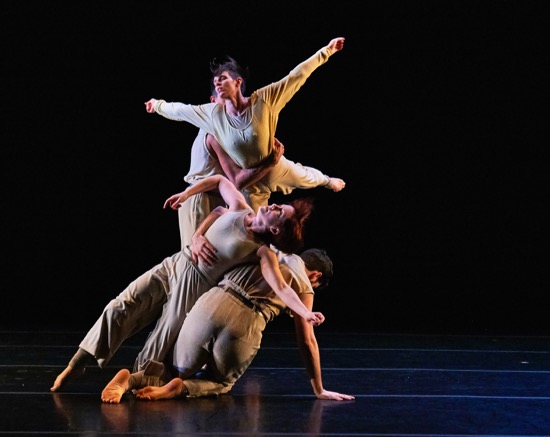
Doug Varone’s Possessed (1994). Visible (front to back): Alex Springer, Whitney Dufrene, and Zan Burley. Photo: Robert Altman
Doug Varone and Dancers is celebrating its 30th anniversary this year, and during the past three decades, Varone has also choreographed dances for other companies, as well as directing and choreographing operas. Knowing that about him, you might expect that his style is not a static one, and you would be correct. In his dances, pauses arrest the flow, just as a stone in a shallow stream temporarily slows the water that hits it; the current always finds a way to speed up again. The dancers slip or swing through space, but also barge through it when the music that’s carrying them along sends that message.
The three dances that his company performed at the BAM Harvey Theater span a dozen years—from the 1994 Possession to the 2015 Folded and the 2016 ReComposed (the last two New York premieres). And in their different ways, all three juxtapose images of freedom and control. The nine dancers can be smooth as silk, or deliberately awkward. They may appear to be sensuously responding to winds and tides or diving through them. They mold to one another, then slide apart, collapse, then rise. But they seldom relinquish a semblance of authority; if approaching a cliff edge, they usually stop in time.
Eight of them appear in the revival of Possession: Hollis Bartlett (or Ryan Yamauchi), Jake Bone, Xan Burley, Whitney Dufrene, Colin Stilwell, Alex Springer, Aya Wilson and Hsiao-Jou Tang (at the performance I saw, apprentice Lynda Senisi, danced instead of Wilson). I didn’t know until now that Varone was reading A.S. Byatt’s novel of that title, and that—although he is not telling any stories—ideas and images from that book slipped into his dance. And the music Possession is set to, Philip Glass’s rich, pulsing Concerto for Violin and Orchestra, swirls them together and apart. Their costumes by Lynne Steincamp, are in neutral hues, with only subtle differences between them.
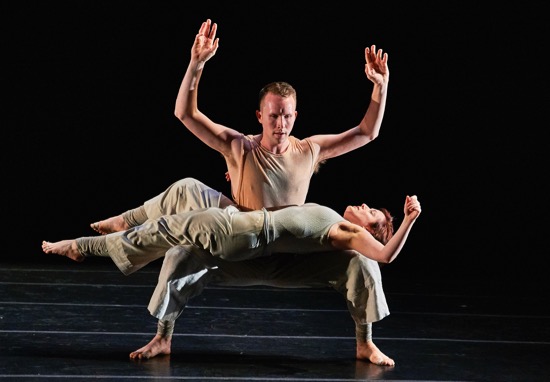
Jake Bone and Whitney Dufrene in Doug Varone’s Possessed. Photo: Robert Altman
I’d forgotten, if I ever knew, about Byatt’s influence on Varone. It’s interesting to think about. In the novel, two present-day scholars join together in researching two 19th-century poets who may have had an affair (this is a simplification of the plot, which involves other lovers and mates of the protagonists and unexpected family connections). Duets are prominant in Varone’s Possession, and its second and third sections are quartets. These can project hint of drama, aided by David Ferri’s lighting. Burley and Stilwell collapse together, supine, he grasping one of her legs. Bone sets his feet wide apart and bends his knees deeply; and Dufrene lies athwart his thighs (how did that happen?). She’s stiff, but her head has fallen back, and Bone holds his hands up, so she seems to be just there, like a summoned-up vision. Another pair or two will repeat the image. At one point, Stilwell, Springer, Tang, and Burley seem, briefly, to be fading away. Stilwell and Burley are about to kiss, but instead exit, as does Springer, leaving Tang alone, as the second movement ends. But these images surface like flotsam, floating on a sea of dancing.
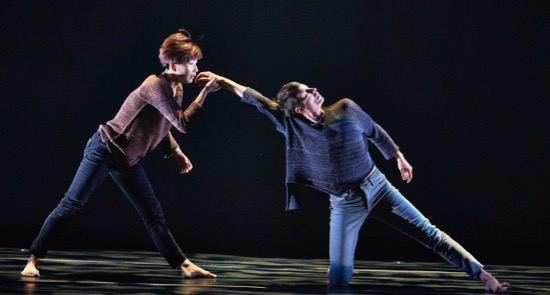
Hsiao-Jou Tang about to kiss Xan Burley’s hand in Doug Varone’s Folded. Photo: Robert Altman
Folded can be performed by either two men or two women. I saw Burley and Tang. They perform the duet to Julia Wolfe’s Believing—a vigorous, driving, intriguingly textured work, composed for Bang on the Can All-Stars (cello, bass, guitar, clarinet, keyboard, and percussion). Under showers of light by David Grill that pattern the floor, the two dancers connect in many possible ways—leaping in unison, stepping over each other. Tang falls suddenly; Burley balances on one leg for a while. They find ways to connect, to hold each other. The ending is curious. Slowed down, they walk toward us, shaking their heads, as the lights go out. “Folded” as in “the show folded?” Whatever their relationship was, it’s over.
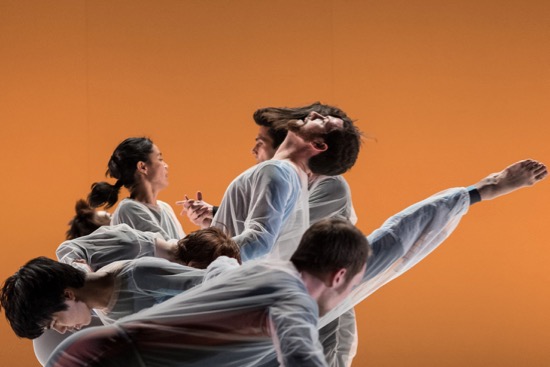
Doug Varone’s ReComposed. Visible (front to back):Jake Bone, Ryan Yamauchi, Hollis Bartlett, Aya Wilson, and Alex Springer. Photo: Nikki Carrara
ReComposed, like Possession, was influenced by another art form. Varone found the work of the artist Joan Mitchell enthralling—her slashes of color, bright tangles of wiry lines, grass-blade clusters in electric hues, and also the ways in which she faded or blurred these. Its music is Dystopia, by Michael Gordon (like Wolfe, his wife, one of Band on a Can All-Stars’ founders), a composition for symphony orchestra. Written to accompany a film by Bill Morrison, showing footage of disasters subjected to damaging film processes, it also envisions the future of the city of Los Angeles, which a note on the composer’s website characterizes as “frenzied, chaotic, dazzling, electric, and ultimately…loud.”
Not, then, a soothing dance. The eight cast members have their own ways of entering and leaving, weaving or streaking through congestion, changing directions to avoid collisions, shocked into action, at times obedient to traffic patterns. To add to the uneasy atmosphere, Robert Wierzel’s lighting bathes the backdrop and floor in Easter-egg colors. Imagine yourself driving through fantasy neighborhoods. Deep pink yields to green, to lavender, to orange-pink in a matter of a few minutes and keeps changing. The dancers’ costumes (by Reid Barthelme and Harriet Jung) are muted initially; pale, translucent jumpsuits veil glimpses of black or hints of color. As the dance progresses, now one, now two, now everyone sheds that outer covering to reveal individualized black unitards patched with one or more bright-colored vertical strips.
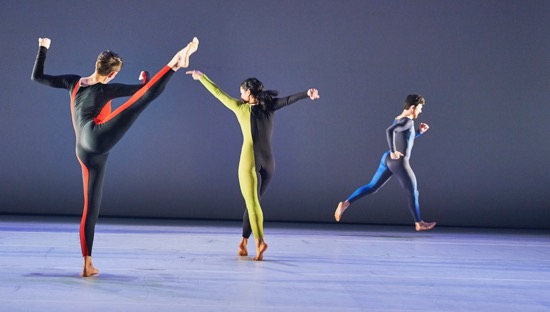
Doug Varone’s ReComposed. (L to R): Xan Burley, Aya Wilson, and Hollis Bartlett. Photo: Robert Altman
The changing lights and the driving music abet the vision of a dystopian society. You get the impression that these people have to be where they are; they react to crashes in the music and take advantage of its rare quieter moments to gesture or move slowly and deliberately. Once, in near silence, they freeze in a tableau, as if halted by a traffic light. Once, their feet skid over the floor. From disorder, a line forms from the front of the stage to the back, but as those in it try to travel in that pattern, it bulges and contracts and whips around. Roadblocks coalesce and dissolve, people collide in midair, grasp one another’s hands, and grapple with invisible forces. Someone gets lifted, someone falls suddenly, two people find a common activity. Nothing seems to last more than a few seconds. Sometimes all of the dancers are alone together, their bodies jabbering, their arms signaling or whacking the air in individual ways. At one point, Burley starts shaking rapidly and with so much tension that you think she’ll fly into pieces.
Varone composes chaos in this work with dazzling skill, and the dancers are splendid, as they have been all evening: daredevils with wise bodies, able to understand the forces they’re controlling and the impulses that beset them. Here’s to ten fertile years ahead and another anniversary.
